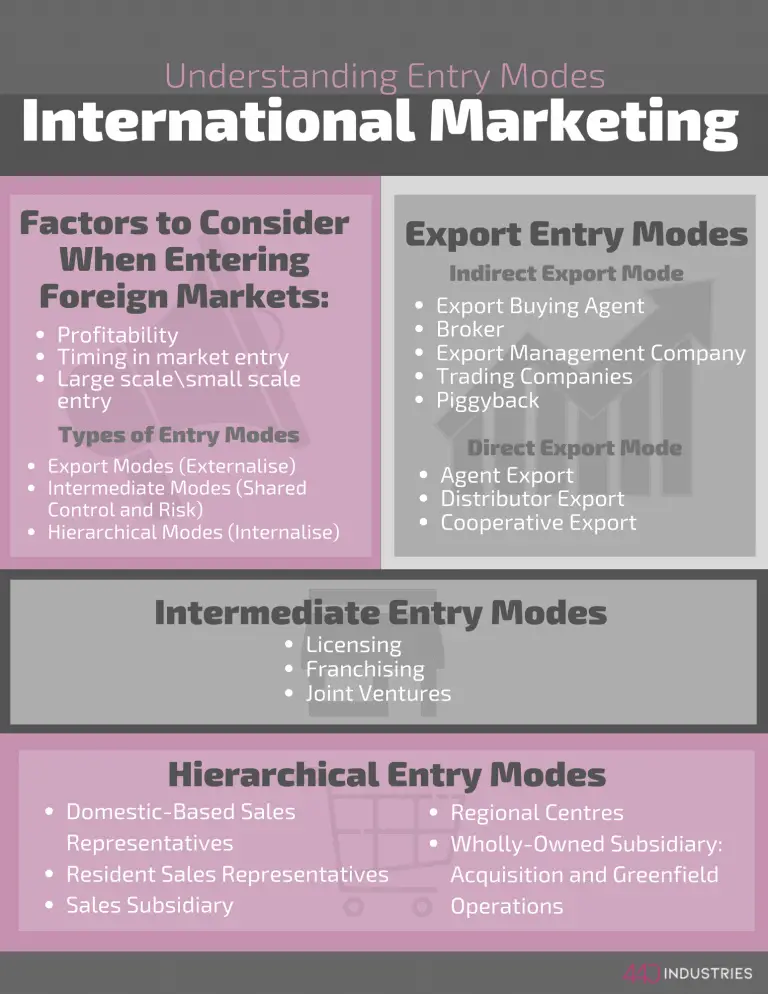Introduction
As companies grow and gain competitiveness, the choice to start developing a market outside of national boundaries becomes less of a choice, and more of a necessity. Usually, in academic literature, we make a distinction between those companies that develop an international marketing strategy in order to seize an opportunity (due to proactive motives), and those companies that instead pursue foreign customers to react towards adverse domestic conditions (reactive motives). The decision to select a particular market to enter relies on instinct just as often as on data and research, but once the market has been targeted, it’s necessary to address a new set of decisions, which pertain to entry strategy.
In this post, we are going to address the options that a company may have available when entering foreign markets. This is the breakdown of the article’s content.
These are the subsections of our article.
1. Factors to Consider when entering foreign markets
2. Types of Entry Modes
3. Export Entry Modes
4. Intermediate Entry Modes
5. Hierarchical Entry Modes
6. Concluding Remarks

1. Factors to Consider when entering foreign markets
There are a variety of factors we should take into account when entering foreign markets, as for many other types of business operations, it’s a riskreward equation.
These are 4 factors to take into account when choosing the best potential market for a company willing to internationalise.
Long TermShort term profitability. This is a very important factor. As developed economies may offer more ‘ready’ markets with strong competition, developing economies may offer long-term opportunities for market development. In both cases, we have a set of advantages and disadvantages.
A competitive market is a synonym with a ‘defined’ market, where much information is available regarding consumer behaviour, pricing, distribution, promotions and product development. Those companies who enter ‘mature’ markets can take advantage of this situation to develop a new, more persuasive, value proposition.
Timing in Market Entry. Markets which are instead ‘unready’ or ‘developing’ often provide a very high riskreward balance. First entrants, or ‘early movers’ may have both an advantage and a disadvantage. The advantage is related to not experiencing competition when establishing their brand name, allowing them to develop consumer loyalty before other companies do, through soft and hard lock-in strategies. On the other hand, these same companies will entail in higher entry costs, as when introducing new countries, firms will need to account for costs associated with consumer education. The introduction of new products, which may be culturally distant from the consumers, will need to be supported via ad-hoc promotional strategies aimed at delivering the product offer within the framework of a new culture. This unique mix of benefits and limitations explains why we have both a first-mover advantage and a first-mover disadvantage.
Large ScaleSmall Scale Entry. This element relies on the particular industry at stake. For certain typologies of organisations, it is possible to establish a small-scale presence, in key locations. An example is provided by the fashion industry, whereby the physical store in one strategic spot, can be enough to connect to foreign customers. Other types of industries instead – for instance, high street banks – will need to cover a foreign market much more extensively in order to establish a presence capable of reaching foreign customers.
Unavoidable uncertainty. Regardless of any degree of information, we may have available, it is clear that there are many grey areas. As a general rule in international marketing, we tend to have an ethnocentric, self-centred approach pushing us to apply ‘what works’ in our domestic market into foreign and developing economies. This approach, however, can be very limiting as it does not take into account stark differences across the world.
2. Types of Entry Modes
Entry modes are divided into three categories.
- Export Modes (Externalise)
- Intermediate Modes (Shared Control and Risk)
- Hierarchical Modes (Internalise)
The balance between these three modes rests on the relationship between an internalisingexternalising approach.
With externalisation companies have, lower cost and low risk, but also low control. This approach is very flexible as it allows firms to put off major investments while testing the market. This is a more cost-conscious approach and is pursued as a first step before entering in more committing professional relationships. The relationships built with this approach are essentially built with agents and distributors.
With shared control, firms rely on business partnerships to manage their firm’s value chain. This allows for a fairly higher cost but accounts for the creation of more valuable assets abroad. These assets rely mostly on building relationships with manufacturing plants and other production facilities.
Through internalising approaches companies actually gain the highest possible degree of control, as they own and manage every link of the value chain, domestically and abroad. This type of international entry strategy is the one pursued by either companies with a high degree of competence in international business management, developed through the export, and intermediate mode of entry (according to the Uppsala Model) or companies who need to invest abroad to create more efficient and cost-effective value chains (according to the TCA Analysis Model).
If we look at the many variables at play we can understand that each firm factor will induce the adoption of one of the three modes of entry, depending on:
- the product
- the firm’s internal characteristics
- the desired mode of entry
- the nature of the transaction
- external political and social factors factors
If we focus on the behaviour of managers, instead of focusing on the international market conditions, we notice three types of ‘rules’ which apply to entry strategy.
Naive rule. This approach is synonym with ‘tunnel vision’ and relates to the fact that managers, may be single-minded in their pursuit of a specific foreign market. This can be due to a variety of issues and biases, however, is often associated with a certain degree of naivety or inexperience.
Pragmatic rule. This approach is the most cost-conscious as managers may pursue an approach whereby companies start entering foreign markets with a low-risk strategy, before addressing more high-risk operations.
Strategic rule. This approach is based on an extensive analysis of the match between firm competitiveness and foreign market in order to select a variety of entry modes looking for the best mix of strategies to target foreign markets. This approach is riskier than the pragmatic rule because again, it’s strategic, and therefore discretional.
3. Export Entry Modes
Export modes of entry are a great place to start as they do provide immediate short-term benefits. Export modes are low-cost entry strategies, which provide companies with a quick entry route into the foreign market. At the same time, export modes rely on the absence of tariff barriers, and the relationship with buying agents. Both of these limitations can become problematic, therefore pushing a firm to pursue alternative or additional entry modes.
Export Modes are divided into two categories, indirect export and direct export. The distinction between indirect and direct export relates to the country where the relationship with the exporting partner takes place. If it takes place in the producer’s domestic country, we have an indirect export mode, if it takes places abroad we have a direct export mode.
Indirect Export Mode
In the indirect export mode, we have the following typologies of relationships.
- Export Buying Agent
- Broker
- Export Management Company
- Trading Companies
- Piggyback
- Export Buying Agent. The export buying agent is a representative of foreign buyers who are located in the exporter’s home country. The agent’s job is to offer the domestically acquired product to foreign potential sellers and negotiate the price of sale. The agent is essentially the overseas’ customer purchasing agent in the exporter’s domestic market. The agent essentially becomes a domestic buyer, scanning the market for the particular merchandise it needs to buy and agrees on the lowest bidder, with no relationship involved. His profit derives from the difference between the purchase price and the selling price.
- Broker. A broker is a different typology of an agent, which instead focuses on creating opportunities to create connections between buyers and sellers. The opportunity is monetised by asking a commission on the realised transaction. The broker is usually someone who has advanced expertise in a particular class of products.
- Export Management Company. EMC are companies which are specialised in working as an ‘export department’ for a range of non-competing companies. EMCs manage all the export process in the name of the client and may provide additional services by focusing on a geographical area, product or consumer type. A company willing to hire an Export house needs to find the right one for the job.
- Trading Companies. Trading companies are large-sized commercial intermediaries, able to undertake both export and import activities. Trading companies sell either on their own behalf or on behalf of a third party. In the latter case, they may support the exporting companies with finance, logistics, and managerial and marketing services necessary for the development of the exporting companies’ presence abroad. This support may be offered from the outset beginning with market research, feasibility study, negotiating assistance or – at more advanced stages – including contracting and documentation, transportation, logistics management, and storage.
- Piggyback. When piggybacking the export-inexperienced SME called ‘rider’ operates through a larger company called ‘carrier’ which already operates in foreign markets and is willing to act on behalf of the rider that wishes to export to those markets. The rider uses the carriers’ international goods’ distribution. These allow for some advantages as the carrier can maximize the capacity of its export operations, or widens its product range.
Direct Export Mode
This mode of entry entails three potential formats:
- Agent Export
- Distributor Export
- Cooperative Export
- Agent. An agent is an independent company that sells on to the customers on behalf of the manufacturer. This is a form of service which does not foresee for stock management and allows for-profit on commission.
- Distributor. These are independent companies that stock the manufacturer’s product. Distributors will have more freedom in choosing their own customers and price, as the profit will depend on the difference between the buy price and selling price.
Both of these formats rely on a fundamental advantage that agents and distributors have in relation to the firm: market knowledge. Agents and distributors already have established business contacts which are used for the benefit of the company. In both models, having profit linked to sales makes these options cost-efficient, but less likely to develop a market in the long term. At the same time, this approach can be used as a form of marketing testing – even though it may be challenging to use an agent as a source of reliable information.
- Cooperative Export Modes. Cooperative Export Modes instead are created when companies join forces to create a product line which is going to be exported abroad, while at the same time creating an organisation which will draw from each company’s individual core businesses. This is because in certain industries (like furniture manufacturing) product lines can be very fragmented and not reach economies of scale making them unsuitable for foreign export. Among the benefits that this approach entails we have the consolidation of rates for exports, making the firms more likely to strike better deals when dealing with higher volumes.
Final reflections on Export modes. As seen so far export relies heavily on the figure of the intermediary. Companies are forced to use intermediaries as a tool to explore markets where they may have limited knowledge. At the same time, finding the right type of intermediary can be very challenging as many factors can interplay in the selection of the right business partner, such as:
- Financial consolidation
- Geographical coverage
- Level of marketing expertise
- Technical know-how
- Support services offered
- Industry relations
Mapping these factors visually can provide companies with a tool to match the desired factors of success with the profile of potential candidates.
4. Intermediate Entry Modes
Even though there are a variety of reasons that make export modes a viable entry strategy, there are also many other reasons that will encourage a company to switch to intermediate modes of entry. In this case what happens is that production is moved to a foreign country, to pursue the following benefits.
- The opportunity of being closer to the customer
- Lower foreign production costs
- Transportation costs may render heavy or bulk productions non-competitive
- Accessing governmental favour towards national suppliers
This is usually done via contract manufacturing, whereby manufacturing is outsourced to an external partner specialised in production or production technology. Benetton and IKEA are well-known companies which adopt this method. Contract manufacturing is grounded on paying a foreign manufacturer on the basis of the unit produced, this way, by not establishing a wholly-owned subsidiary, an organisation can decide to exit a country with a limited sunk cost.
There are three main Intermediate Entry Modes.
- Licensing
- Franchising
- Joint Ventures
- Licensing. In licensing, a licensor gives a right to the licensee (against payment). In the context of international marketing, the right given is the opportunity to manufacture a certain product based on a company’s IP or patent, in exchange for the payment of an agreed royalty. There are two typical two formats for licensing: standalone (the contract works as a legal basis for the transfer of rights and enable the licensor to earn royalties) or licensing plus (the licensing contract has a relationship orientation and foresees clauses regarding R&D). Among the elements covered by a licensing agreement we find the following:
-
- Patents covering the product or the manufacturing process.
- Manufacturing know-how
- Technical advice and assistance
- Marketing advice
- Use of the trademark
In exchange the licensee usually pays to the licensor through one of the following:
- A lump sum, not related to the production output for knowledge transfer
- A minimum royalty with the guarantee of a minimal annual income
- A running royalty, which consists of a percentage of the selling price or a fixed amount for the production output.
This model provides a variety of benefits for the licensor, despite incurring in a selection of risks which are due to the fact that this approach can create brand dilution or knowledge spillover. Academia still argues that:
- The licensor will maintain technological superiority
- The licensor will not have to invest in a foreign production facility
- Through licensing, the Product Life Cycle can be stretched, by selling abroad
- Profits in licensing are quite high as the intangible brand add a lot of value
- Government regulations may restrict investment in foreign countries
- Licensing can assist in overcoming restrictions on imports
There are also some valuable benefits for licensees as with the appropriate deal, they can get quick returns on small investments.
- Franchising. In the case of franchising, the franchisor gives the right to the franchisee to use a brand and business format against the payment of a sum of money. Franchise agreements cover the right to use a total business concept, but a distinction can be made between product and trade name franchising where the relationship is very similar to trademark licensing and business format package. In this latter case, a relationship is created between an entrant – the franchisor – and a host country entity – the franchisee – to which the franchise is sold. The franchisor is therefore in the position of better controlling every aspect of the operation allowing to directly influence the way the franchisee will adapt the business format to the local resources and knowledge.
The franchising package will typically include:
- Trademark Name
- Copyright and Intellectual Property
- Design
- Patents
- Trade Secrets
- Know-How
- Geographic Exclusivity
- Store Design
- Market Research for the Area
- Location Selection
There are some striking similarities between a licensing and franchise agreement, which make them sometimes hard to tell apart, depending on the nature of the deal.
- Joint Ventures. A joint venture is a strategic alliance or a partnership between two or more parties which is caused by the opportunity to work together.
The venture is usually ignited by:
- Complementary technology and management skills
- The opportunity to increase the speed of market entry
- The necessity to enter foreign markets through partnerships, due to the protective stances adopted by several developing countries aimed at protecting the domestic market.
- Cost savings, as global operations’ management, are very expensive.
As a result, there are two traditional forms of joint ventures that can be created: a joint venture where a new entity is being created or a joint venture (non-equity joint venture) where the venture is based on a contractual relationship.
The typology of the collaboration will, therefore, take up one of the 3 following forms:
Upstream Collaboration (Y Coalition). A and B collaborate on R&D andor production.
Downstream Collaboration (Y Coalition). A and B work on Marketing, distribution, sales and services.
UpstreamDownstream Collaboration (X Coalition). A and B work each on the top or bottom of the value chain. This can happen when the two firms can have complementary competencies.
5. Hierarchical Entry Modes
In this last mode of entry, a company completely owns and controls the foreign entry mode. The degree of control that a firms’ HQ can exert onto the subsidiary depends on how many and which value chain functions can be transferred to the foreign market.
There are five main Hierarchical Entry Modes.
- Domestic-based sales representatives
- Resident sales representatives
- Sales subsidiary
- Regional Centres
- Wholly-Owned Subsidiary: Acquisition and Greenfield Operations
Domestic-based sales representative.
In this case, we have a sales representative who resides in the home country of the employer and travels abroad to perform sales functions. This is often the case with B2B markets as it allows the creation of relationships that become proprietary assets to the company. In this case, a ‘travelling salesman’ manages relationships with a small number of high-importance clients, which justify international travel.
Resident sales representatives.
In this case, the actual performance of the sales functions is transferred to the foreign market. The two main functions that a sales representative must do are:
- Order-making and order-taking, in order-taking this option is not particularly useful, so a Travelling Salesman could be a good option.
- Communicating the nature of the product when the product presents complexity. In this case instead, if the nature of the product is technical and complex the presence of a travelling salesperson is not sufficient and a more permanent base is necessary. The Resident Salesman better fits this business need.
Establishing a Branch Office. In this case, the company establishes a formal branch to which a resident person is assigned. A branch is an extension of a legal part of a firm. The creation of a branch office abroad is a medium step between the management of a sales force and the establishment of a physical presence abroad. If the Branch Office proves a productive investment, then a company can decide to establish a foreign subsidiary, which is, by all means, a local company, owned and operated by a foreign company under the laws of the host country.
Sales subsidiary. This is usually the format adopted by an initial foreign presence, as it will be in charge of better managing pricing and distribution. Marketing, however, is usually managed by the HQ to make sure the company image is consistent with the home domestic market.
From an operational perspective, the sales subsidiary will buy the product from HQ and sell it at the local customers, profiting on the price differential. Usually, however, the most important reason for managing these operations is to gain tax advantages or avoid paying tax in the home country. Switching from an agent or sales force to a subsidiary is something which relates both to the cost of operation and to the revenue model of the agents, as above a certain volume of sales, an agent’s commission will be higher than the cost of operation of a local subsidiary.
Sales and production subsidiary. This type of presence looks at the long-term benefits of establishing production facilities abroad. This approach was historically pursued by Japanese automotive companies who established a presence in Europe early on and waited for the market to mature.
By establishing this type of foreign presence companies can gain a very informed position in the markets and gain the following benefits:
- Defend existing business, by continuing to compete globally.
- Acquire more customers, local production provides a degree of commitment that persuades new customers to engage with the firm.
- Save on costs of labour, materials and transport.
- Avoid government restrictions, tariffs and trade barriers.
Cultural and Communication Issues with operating a foreign subsidiary.
As a firm develops new subsidiaries in foreign countries, new challenges may arise. Maintaining a cultural influence over a subsidiary allocated abroad can pose challenges that may impact firm performance heavily.
Usually, there are 4 ways in which HQ culture and values can be transmitted to the foreign subsidiary:
- Integration. The HQ values are maintained in the subsidiary, but the subsidiary also grows an attachment to the new location.
- Separation. The HQ values are transferred, but the company has no direct engagement with the new local premises.
- Assimilation. A company integrates local values and ‘forgets’ HQ values.
- Marginalisation. No culture is transferred to the company not from HQ or from the local scenario, this is recipe for disaster.
Regional Centres.
Sometimes companies will privilege expansion towards a region instead of a single country. This can be done by choosing a lead country which will play the role of coordinating and stimulating sales in the whole geographical region. In the case of regional centres, it’s very important that firms are able to manage all foreign subsidiaries, avoiding conflict and stimulating synergies and collaboration.
An effectively managed regional centre can provide a competitive advantage to an internationalising firm, allowing each lead country to exploit benefits such as:
- Access marketing competencies from foreign subsidiaries
- Acquire international human resources
- Exploit the strategic relevance of countries represented
- Manage production locations
- Address tariff barriers and import restrictions
Crossing over national boundaries allows a firm to acquire additional insights into the management of its operations and its effectiveness in engaging with its customers. Some of the benefits of creating a transnational organisation entail:
- Understand the international appeal of a firm’s brand
- Capture innovation and expertise developed across a geographical region and share it with the rest of the organisation
- Understanding the potential of new product and service ideas
- Managing international teams and focusing them on seizing new market opportunities
Wholly-Owned Subsidiary: Acquisition and Greenfield Operation. In this case, a company has to decide whether to enter a foreign market by either acquiring a local company or creating a company from the ground up.
Acquisition. Acquisition allows firms to rapidly enter a new market and provides at the same time access to distribution channels and an existing customer base. An acquisition additionally allows taking advantage of established brand names or corporate reputation. When a market is saturated, acquiring a company could be an effective way to establish a presence and a slice of the market at the same time.
An acquisition can follow 4 different formats:
- Horizontal (similar products and markets)
- Vertical (the acquired firm becomes supplier or customer of the acquiring firm)
- Concentric (same marketdifferent technology or vice versa)
- Conglomerate (no correlation, different)
Greenfield investment. This is a term designed to describe operations where companies build a subsidiary from the ground up. This is advised when no acquisition targets are available or are too costly to pursue.
This costly option allows for some unique benefits such as:
- The ability to incorporate the latest technology and equipment into the newborn operation.
- Not experiencing inertia or setbacks from the newly acquired company, when required to change operational practices.
6. Concluding Remarks
In this article, we have discussed a wide variety of entry modes which can be pursued by internationalizing firms when accessing foreign countries. All of these options account for risks and rewards, and they need to be assessed with a clear long term vision in mind capable of overcoming the challenge of adapting to a foreign market. A manager should build on his or her professional expertise to understand the tangible and intangible risks associated with international entry strategy.
If you’d like to learn more about international marketing, and you are in need of some additional academic literature on the topic, we recommend the following book: Global Marketing
Moreover, don’t hesitate to explore our blog, where we’re sharing a wealth of information on international marketing for you to dive into!







